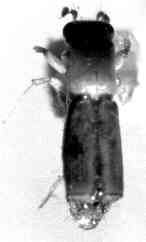
Pin- and Shot-Hole Borers, Ambrosia Beetles
(Coleoptera: Scolytidae and Platypodidae)
(2) Distinctive Features of Scolytidae and Platypodidae
go to main menu
This article is divided into the following headings:
Distinctive Features of Scolytidae and Platypodidae
Pin- and shot-hole borers belong to the two closely related families Scolytidae and Platypodidae. Their name comes from the fact that the beetles bore small pin-holes or larger shot-holes between 0.5 and 3 mm Æ in the wood of living or dying trees as well as in unseasoned timber products. Common are the platypodid genera Crossotarsus, Diapus and Platypus and the scolytids Xyleborus, Webbia pabo, Hylurdrectonus piniarius, Poecilips and Arixyleborus canaliculatus. There is a variety of host species like Araucaria cunninghamii, A. hunsteinii, Tectona grandis, Acacia spp., Eucalyptus deglupta, Calophyllum spp. and Terminalia brassii. Pin- and shot-hole borers cause considerable degradation of wood and timber in PNG, worth about one million Kina per year. Although the bore holes are relatively quickly covered up by growing bark, the galleries will still remain in the wood, decreasing its quality or even making it unsuitable for veneer and ply wood. Often the galleries are penetrated and stained by fungi. In the case of rot, the stability of the timber is decreased so that it is unusable for particular purposes. Apart from that, the presence of pin- and shot-hole borers in timber bound for export can cause serious quarantine problems and result in the rejection of a log shipment.
| Feature | Scolytidae | Platypodidae |
| common name | bark beetles and ambrosia beetles or pin- and shot-hole borers | ambrosia beetles or pin- and shot hole-borers |
| colour of adults | reddish, black or light to brown dark | light to dark brown |
| size of adults | 1 - 6 mm | 2 to several mm |
| shape of adults | cylindrical, slender or stocky in build, with reduced, bowl-shaped prothorax | elongate, less cylindrical, sometimes flattened above |
| colour of larvae | creamy white | creamy white |
| shape of larvae | slightly curved, more stocky in build | curved with humped thorax |
| size of hole in wood | smaller holes, sometimes with resin or long frass pellet | slightly larger hole often with discharged powdery frass |
| duration of life cycle | 4 weeks to several months | 4 weeks to 12 months |
Distinctive features of Scolytidae and Platypodidae
Pin- and Shot-Hole Borers: (left) Crossotarsus porcatus (Platypodidae); (centre) Platypus jansoni (Platypodidae); (right) Xyleborus destruens (Scolytidae)
Pin- and Shot-Hole Borer Damage: galleries made by Crossotarsus spp.; (left) Xyleborus spp.; (right top) Platypus spp. (right bottom) (reproduced from Roberts, H., 1987)
go to previous page
go to general
info on coleopteran pests
go to fire
go to host
trees and their pests
go to glossary
go to main menu
© Michael F. Schneider, 1999